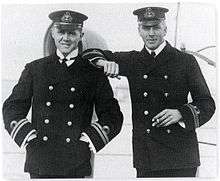HMS E9
 HMS E9 | |
| History | |
|---|---|
| Name: | HMS E9 |
| Builder: | Vickers, Barrow |
| Laid down: | 1 June 1912 |
| Commissioned: | 18 June 1914 |
| Fate: | Scuttled, 3 April 1918 |
| General characteristics | |
| Class and type: | E class submarine |
| Displacement: |
|
| Length: | 181 ft (55 m) |
| Beam: | 15 ft (4.6 m) |
| Propulsion: |
|
| Speed: |
|
| Range: |
|
| Complement: | 30 |
| Armament: |
|
HMS E9 was a British E class submarine built by Vickers, Barrow. She was laid down on 1 June 1912 and was commissioned on 18 June 1914.
Design
Like all post-E8 British E-class submarines, E9 had a displacement of 662 tonnes (730 short tons) at the surface and 807 tonnes (890 short tons) while submerged. She had a total length of 180 feet (55 m)[1] and a beam length of 22 feet 8.5 inches (6.922 m). She was powered by two 800 horsepower (600 kW) Vickers eight-cylinder two-stroke diesel engines and two 420 horsepower (310 kW) electric motors.[2][3] The submarine had a maximum surface speed of 16 knots (30 km/h; 18 mph) and a submerged speed of 10 knots (19 km/h; 12 mph). British E-class submarines had fuel capacities of 50 tonnes (55 short tons) of diesel and ranges of 3,255 miles (5,238 km; 2,829 nmi) when travelling at 10 knots (19 km/h; 12 mph).[1] E9 was capable of operating submerged for five hours when travelling at 5 knots (9.3 km/h; 5.8 mph).
E9 was not fitted with a deck gun during construction, and it is not known whether one was fitted later, as was the case with many boats up to E19. She was the first of her class to be constructed with five 18 inches (460 mm) torpedo tubes, two in the bow, one either side amidships, and one in the stern; a total of 10 torpedoes were carried.[2]
E-Class submarines had wireless systems with 1 kilowatt (1.3 hp) power ratings; in some submarines, these were later upgraded to 3 kilowatts (4.0 hp) systems by removing a midship torpedo tube. Their maximum design depth was 100 feet (30 m) although in service some reached depths of below 200 feet (61 m). Some submarines contained Fessenden oscillator systems.[1]
Crew
Her complement was three officers and 28 men.[1]
Service history

At dawn on 13 September 1914, the submarine, commanded by Lieutenant-Commander Horton, torpedoed the German light cruiser SMS Hela six miles southwest of Heligoland. Hela was hit amidships with the two torpedoes, fired from a range of 600 yards. All but two of her crew were rescued by the German submarine U-18 and another German ship. Although pursued most of the day by German naval forces, E9 managed to reach Harwich safely.[4] Three weeks later, Horton sank the German destroyer S 116 off the mouth of the River Ems. For sinking the cruiser and the destroyer, Horton was awarded the Distinguished Service Order (DSO).
E9 was scuttled outside Helsinki (Helsingfors) 1.5 nautical miles (2.8 km; 1.7 mi) off Grohara Light in the Gulf of Finland on 3 April 1918 to avoid seizure by advancing German forces.
HMS E9 was salvaged for breaking in Finland in August 1953.
References
- 1 2 3 4 Innes McCartney; Tony Bryan (20 February 2013). British Submarines of World War I. Osprey Publishing. pp. 11–12. ISBN 978-1-4728-0035-0.
- 1 2 Akerman, P. (1989). Encyclopaedia of British submarines 1901–1955. p.150. Maritime Books. ISBN 1-904381-05-7
- ↑ "E Class". Chatham Submarines. Retrieved 20 August 2015.
- ↑ "Admiral Sir Max Kennedy Horton, RN". uboat.net. Retrieved 2006-11-26.
- Submarines, war beneath the waves, from 1776 to the present day, by Robert Hutchinson
- Akerman, P. (1989). Encyclopaedia of British submarines 1901–1955. p.150. Maritime Books. ISBN 1-904381-05-7